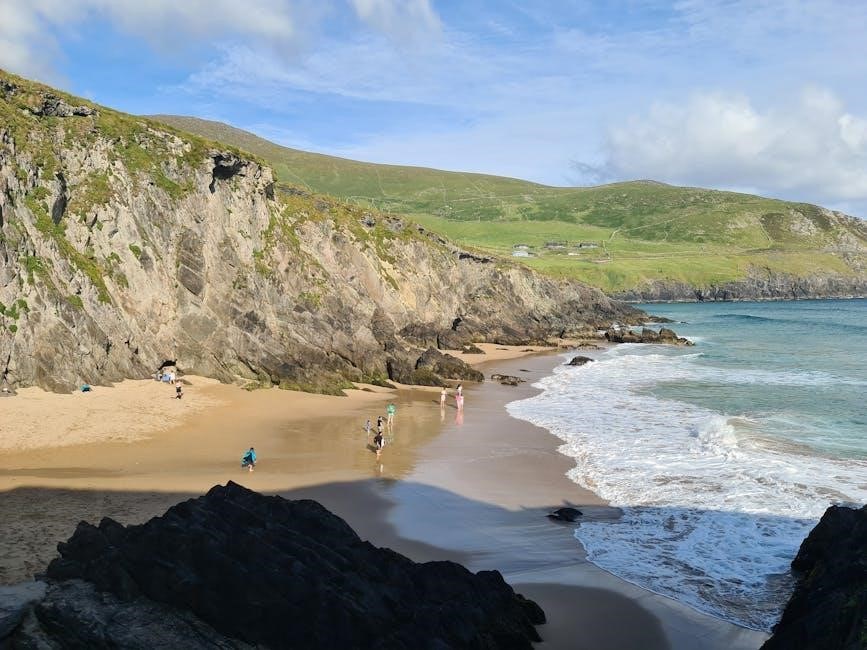The Ireland William Anderson Family PDF provides a comprehensive overview of the Anderson family’s lineage, tracing their roots from Ireland to America and detailing their historical significance.
1.1. Overview of the Ireland William Anderson Family
The Ireland William Anderson Family traces its lineage to William Anderson, born in 1736 in Ulster, Ireland. The family’s history spans generations, detailing their migration to America, settling in regions like Maryland, Virginia, and Tennessee. The PDF document outlines their genealogy, including marriages, children, and notable descendants, offering insights into their cultural and historical contributions to both Ireland and the United States.
1.2. Historical Significance of the Family
The Ireland William Anderson Family holds significant historical importance, particularly in the context of the Scots-Irish migration to America. Their journey from Ulster, Ireland, to regions like Maryland and Tennessee underscores their role in shaping early American settlement and culture. The family’s legacy is marked by contributions to local communities, genealogical connections, and a enduring impact on both Irish and American heritage, making their story a vital part of transatlantic history.

1.3. Purpose of the Ireland William Anderson Family PDF
The Ireland William Anderson Family PDF serves as a detailed genealogical resource, tracing the family’s lineage from Ireland to America. It provides historical records, estate documents, and DNA connections, aiding researchers in uncovering their Irish roots. This document is essential for genealogy enthusiasts, offering insights into the family’s migration, cultural contributions, and enduring legacy, making it a valuable tool for understanding the Andersons’ role in both Irish and American history.
Early Life and Ancestry of William Anderson
William Anderson was born in 1736 in Ireland to James Anderson and Margaret Kilpatrick. He had a brother, James, and a sister, Sussanna, growing up in a traditional Irish setting.
2.1. Birth and Parentage of William Anderson
William Anderson was born in 1736 in Ireland to James Anderson and Margaret Kilpatrick. His birth marked the beginning of a lineage that would span generations. William had one brother, James, and one sister, Sussanna. His father, James, was a respected figure, and the family lived a modest life in Ireland before William’s eventual migration to America. His early life laid the foundation for his future contributions to the family’s history and legacy.
2.2. Siblings of William Anderson
William Anderson had two siblings: a brother, James, and a sister, Sussanna. James married Sarah Young and had four children, while Sussanna’s marital details are less documented. Both siblings played significant roles in the family’s expansion and legacy. Their lives and descendants contributed to the Anderson family’s growth across Ireland and America, shaping the family’s historical narrative and cultural impact over generations.
2.3. Early Life in Ireland
William Anderson was born in 1736 in Ireland to Margaret Kilpatrick and her husband. His early life was marked by a quiet disposition and good intellect. Raised in a traditional Irish setting, he developed strong values that shaped his future. His upbringing laid the foundation for his later roles as a family man and immigrant, influencing his journey to America and the legacy he would build.

Marriage and Children of William Anderson
William Anderson married Jane Bryan in Ireland, with whom he had twelve children. Their marriage and family life laid the foundation for their future in America.
3.1. Marriage to Jane Bryan
William Anderson married Jane Bryan in Ireland, a union that formed the cornerstone of their family legacy. Jane, known for her strong character and piety, was the daughter of Andrew Bryan. Together, they had twelve children, blending their Irish heritage with future American roots. Their marriage, marked by resilience and faith, laid the foundation for their enduring family legacy across generations in Ireland and America.
3.2. Children of William and Jane Anderson
William and Jane Anderson had twelve children, including six sons and six daughters. Their eldest, James, was born in Maryland, followed by John in Cecil County. The family expanded as they moved to New Jersey, Virginia, and Tennessee. Each child contributed to the family’s growth, with notable descendants shaping both regional and national history. Their legacy reflects strong family bonds and a enduring impact on American society.
3.3. Family Life in Ireland and Migration to America
William and Jane Anderson lived in Ireland before migrating to America in 1762. They settled initially in Maryland, where their eldest child, James, was born. The family later moved to New Jersey, Virginia, and Tennessee, establishing a strong presence in each region. Their migration marked the beginning of a new chapter for the Anderson family, shaping their legacy in both Ireland and the United States through their resilience and determination.
Migration to America and Settlement
The Anderson family migrated from Ireland to America in 1762, settling initially in Maryland before moving to New Jersey, Virginia, and eventually Tennessee, establishing roots in each region.
4.1. Journey from Ireland to America
The Anderson family’s journey from Ireland to America began in 1762 when William and Jane Anderson set sail across the Atlantic. Their voyage lasted thirteen weeks, reflecting the challenging conditions of 18th-century transatlantic travel. Upon arrival, they settled initially in Maryland, marking the start of their new life in the American colonies. This migration was part of the broader Scots-Irish movement, driven by economic and religious motivations.
4.2. Settlement in Maryland and New Jersey
After arriving in America, William and Jane Anderson initially settled in Maryland, where their eldest son, James, was born. The family later relocated to New Jersey, near Monmouth Court House, where additional children, including John, Sarah, and William, were born. These early settlements laid the foundation for the Anderson family’s roots in colonial America, marking the beginning of their enduring presence in the region.
4.3. Movement to Virginia and Tennessee
William Anderson and his family moved to Virginia around 1770, settling near Staunton, where Sussanna was born. By 1773, they relocated to Holston (now Sullivan County), Tennessee, establishing a homestead. The family thrived there, with Andrew and Mary born on the property. Later, they moved to Island Road in 1775 or 1776, further expanding their roots in the region, which became a cornerstone of their American legacy.
Personal Life and Characteristics of William Anderson
William Anderson, born in Ireland in 1736, was a man of good intellect and sober habits. He stood at five feet nine inches, with a fair complexion, small feet, and hands. Married to Jane Bryan, he exhibited quiet determination and a strong moral compass, shaping his family’s legacy.
5.1. Physical Description and Personality
William Anderson, born in 1736, stood at five feet nine inches with a fair or sandy complexion. He had small feet and hands, giving him a comely appearance. Known for his quiet and well-disposed nature, William was a sober citizen with good common intellect. His personality reflected strength and resilience, traits that would shape his family’s legacy and endeavors across generations.
5.2. Career and Contributions
William Anderson’s career and contributions were marked by his role as a farmer and family patriarch. He managed land in Maryland, New Jersey, and Virginia, ensuring the family’s stability. His quiet leadership and sobriety earned him respect, while his marriage to Jane Bryan and fatherhood of twelve children solidified his legacy. William’s prudent decisions and hard work laid the foundation for future generations, highlighting his enduring impact on both his family and community.
5.3. Later Life and Death
William Anderson spent his later years in Sullivan County, Tennessee, where he passed away in 1789. His wife, Jane Bryan, died in 1819. Together, they left a lasting legacy through their twelve children, whose descendants spread across the United States. Their enduring impact on the family’s history and the regions they settled in remains a testament to their resilience and contributions.

Legacy of the Ireland William Anderson Family
The Ireland William Anderson family left a profound impact on Irish and American history, shaping cultural and social landscapes through their resilience and contributions across generations.
6.1. Impact on Irish and American History
The Ireland William Anderson family significantly influenced both Irish and American history. Their migration from Ireland to America during the 18th century contributed to the Scots-Irish diaspora, shaping colonial settlements. The family’s resilience and adaptability played a crucial role in establishing communities in regions like Maryland, Virginia, and Tennessee. Their legacy reflects the cultural and social ties between Ireland and America, leaving a lasting impact on the history of both nations.
6.2. Notable Descendants
The Ireland William Anderson family boasts notable descendants who excelled in various fields. James Anderson, a prominent surveyor, and John Anderson, a respected community leader, played key roles in shaping local histories. Their contributions to agriculture, education, and civic life left a lasting legacy. The family’s descendants continued to thrive, becoming influential figures in both Ireland and America, ensuring their ancestors’ impact endures through generations.
6.3. Cultural and Social Contributions
The Ireland William Anderson family made significant cultural and social contributions, preserving their Scots-Irish heritage while adapting to American life. They played roles in agriculture, community leadership, and education, fostering strong family ties and traditions. Their migration and settlement patterns influenced local cultures, while their values of resilience and faith shaped societal norms. The family’s legacy continues to inspire, bridging their Irish roots with American progress.

Other Prominent Family Members
The Ireland William Anderson family produced notable figures like James, John, and Samuel Anderson, who excelled in community leadership, agriculture, and education, shaping cultural and social landscapes.
7.1. James Anderson and His Lineage
James Anderson, the eldest son of William and Jane, was born in 1763 in Maryland. He married Hester Anderson, his cousin, and had a large family. Five of their children were deaf and dumb but possessed good minds and physical appearance. Despite his intemperance, James’ wife was noted for her beauty and kindness. The family relocated to Bedford County, Tennessee, where both James and Hester passed away, leaving a lasting legacy in the region.
7.2. John Anderson and His Role in the Family
John Anderson, born in 1765 in Cecil County, Maryland, was a prominent figure in the family. He married Rachel Roberts and had twelve children, showcasing strong family values. Known for his temperate lifestyle, he avoided alcohol and tobacco, reflecting a disciplined character. As a surveyor in Sullivan County, Tennessee, John contributed significantly to the community. His legacy endures through his descendants, who continued the family’s traditions and values, leaving a lasting impact on their surroundings.
7.3. Other Notable Figures in the Family Tree
Dr. William Anderson, born in 1837 in Fermanagh, Ireland, was a notable descendant, known for his intellectual contributions. Another prominent figure was William Anderson, who married Nancy Stephenson Stinson in Ballymoney, Ireland, emphasizing the family’s enduring Irish roots. Additionally, William Willie Anderson, born in 1744 in County Antrim, played a significant role in maintaining the family’s cultural heritage, leaving a lasting legacy for future generations to explore and appreciate.

DNA Connections and Genealogical Research
DNA links confirm the Anderson family’s Irish origins, with connections to descendants like Samuel and Susanna Criswell, aiding genealogical research and preserving the family’s historical legacy.
8.1. DNA Links and Family Connections

DNA research confirms the Anderson family’s Irish roots, linking descendants like Samuel and Susanna Criswell to William Anderson of Ulster. Genetic matches reveal connections to the Yancey family, with Elizabeth Yancey marrying William’s son. These links have helped trace the family’s migration from Ireland to America, confirming historical records and enriching the Anderson family tree with verified lineage and ancestral ties.
8.2. Genealogical Resources and Tools
The Ireland William Anderson Family PDF highlights key genealogical resources, including estate records, census data, and wills; Tools like DNA testing and online platforms have connected descendants globally. Historical documents, such as William Anderson’s 1827 will, provide insights into family lineage. These resources, combined with family trees from sites like YanceyFamilyGenealogy.org, aid researchers in tracing the Anderson family’s migration and legacy, ensuring accurate and detailed genealogical reconstruction.
8.3. Modern-Day Family Research
Modern research on the Ireland William Anderson Family leverages DNA testing and digital archives to connect descendants worldwide. Online platforms and forums facilitate collaboration, while the PDF document serves as a central resource. Genealogists use tools like census records and wills to verify lineage. This blend of technology and traditional methods ensures accurate tracing of the Anderson family’s legacy, bridging generations and continents with precision and clarity.
Family Crest and Coat of Arms
The Anderson family crest features heraldic symbols like lions and crosses, representing strength and faith. The coat of arms signifies the family’s noble heritage and historical legacy.
9.1. Description of the Anderson Family Crest
The Anderson family crest features a lion rampant on a shield, symbolizing courage and strength. A cross and stars are often included, representing faith and divine guidance. The crest’s colors, typically red, gold, and blue, signify nobility, wisdom, and loyalty. This heraldic design reflects the family’s rich history and legacy, tracing back to their Scottish and Irish roots.
9.2. Historical Significance of the Crest
The Anderson family crest holds deep historical significance, tracing back to the clan’s Scottish origins. It symbolizes the family’s values of courage, faith, and loyalty. The crest’s design has been passed down through generations, serving as a unifying symbol for the Anderson lineage. It reflects their heritage and the cultural ties that bind the family across Ireland and America, preserving their identity and legacy through the centuries.
9.3. Use of the Crest in Modern Times
The Anderson family crest continues to symbolize heritage and unity in modern times. It is often displayed at family reunions and cultural events, serving as a visual link to their Irish and Scottish roots. Genealogists use the crest in research materials, such as the Ireland William Anderson Family PDF, to illustrate the family’s history and legacy. Additionally, the crest is featured on memorabilia, fostering a sense of pride and connection among descendants.

Historical Records and Documents
The Ireland William Anderson Family PDF includes estate records, census data, and land deeds, offering insights into the family’s historical land ownership and migrations across Ireland and America.

10.1. Estate Records and Land Ownership
The Ireland William Anderson Family PDF details extensive estate records, revealing land ownership in Ireland and America. Historical documents show the family acquiring and managing large estates, particularly in Sullivan County, Tennessee, and other regions. These records highlight their agricultural contributions and the strategic management of properties over generations, underscoring their significant role in settling and developing new areas.
10.2. Census Data and Population Records
Census records provide valuable insights into the Ireland William Anderson family’s movements and growth. Data from 1763 onward traces their migration from Ireland to America, detailing family sizes and locations. The 1940 census, for instance, shows the family residing in Illinois with an 8-year-old daughter, Donnalee Barbour. These records are essential for mapping the family’s demographic evolution and geographic spread across generations.
10.3. Wills and Probate Documents
Wills and probate records provide critical insights into the Ireland William Anderson family’s estate management and lineage. William Anderson’s 1827 will, for instance, divides property among his children and appoints executors. His wife, Elizabeth’s, 1844 noncupative will further details asset distribution. These documents offer a glimpse into the family’s financial dealings, inheritance patterns, and generational transitions, serving as vital resources for genealogists tracing the Anderson family’s legal and economic history.
The Scots-Irish Migration Context
The Scots-Irish migration shaped the Anderson family’s journey from Ulster to America, reflecting broader historical patterns of movement and settlement that influenced their identity and legacy.
11.1. Historical Background of the Scots-Irish
The Scots-Irish were Scottish Presbyterians who settled in Ulster, Ireland, during the 17th-century Plantation of Ulster. Facing economic hardship and religious tensions, many migrated to America in the 18th century, particularly during the 1718 exodus led by Rev. James MacGregor. This migration wave shaped the cultural and social fabric of both Ireland and America, influencing families like the Andersons, who became part of this significant historical movement.
11.2. Role of the Anderson Family in the Migration
The Anderson family played a significant role in the Scots-Irish migration, with William Anderson Sr. and his wife, Jane Bryan, emigrating from Ireland to America in 1762. They settled in Maryland before moving to New Jersey and later Virginia. Their migration contributed to the cultural and social dynamics of the regions they inhabited, establishing a legacy that shaped their descendants’ lives and the broader Scots-Irish community in America.
11.3. Impact of the Migration on the Family

The migration from Ireland to America profoundly shaped the Anderson family’s future. It allowed them to establish new roots, expand their lineage, and thrive in diverse regions. Their relocation facilitated cultural adaptation and economic opportunities, leading to a large, influential family presence in America. The migration also preserved their heritage while fostering a resilient and resourceful spirit among their descendants, ensuring a lasting legacy in both Ireland and the United States.
The Ireland William Anderson family’s legacy endures through meticulous genealogical records, showcasing their journey from Ireland to America and their lasting impact on history and culture.
12.1. Summary of the Ireland William Anderson Family History
The Ireland William Anderson family traces its roots to Ulster, Ireland, with William Anderson, born in 1736, leading the migration to America in 1762. Settling initially in Maryland, the family later moved to New Jersey, Virginia, and Tennessee. William and his wife, Jane Bryan, had twelve children, establishing a legacy that spans generations. The family’s history is meticulously documented in the Ireland William Anderson Family PDF, offering insights into their genealogy, migration, and cultural impact.
12.2. Final Thoughts on the Family’s Legacy
The Ireland William Anderson family’s legacy is one of resilience and enduring impact. From their origins in Ireland to their settlement in America, the family played a significant role in shaping both Irish and American history. Their story, preserved in the Ireland William Anderson Family PDF, serves as a testament to their contributions and enduring influence across generations, offering valuable insights for genealogy enthusiasts and historians alike.
12.3. Encouragement for Further Research
Exploring the Ireland William Anderson Family PDF offers a compelling foundation for further genealogical research. By examining estate records, census data, and DNA connections, enthusiasts can uncover deeper insights into the family’s heritage. This document serves as a valuable resource for anyone tracing their Irish roots or seeking to understand the broader historical context of the Anderson family’s journey from Ireland to America and beyond.